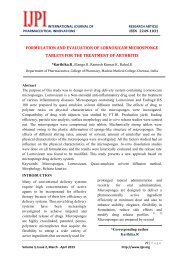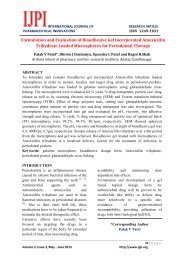MORPHO ANATOMICAL STUDIES OF LEAVES OF Urena ... - IJPI
MORPHO ANATOMICAL STUDIES OF LEAVES OF Urena ... - IJPI
MORPHO ANATOMICAL STUDIES OF LEAVES OF Urena ... - IJPI
Create successful ePaper yourself
Turn your PDF publications into a flip-book with our unique Google optimized e-Paper software.
INTERNATIONAL JOURNAL <strong>OF</strong><br />
RESEARCH ARTICLE<br />
PHARMACEUTICAL INNOVATIONS ISSN 2249-1031<br />
stained with safranin, fast-green and iodine<br />
solution for the identification starch.<br />
For stomatal morphology, venation pattern<br />
and trichomes distribution, paradermal<br />
sections of leaf was taken cleaned with<br />
sodium hydroxide solution (5%) and<br />
epidermal peeling by partial maceration<br />
(Jeffrey’s maceration fluid). Temporary<br />
preparations of the above macerated /<br />
cleared materials were made with<br />
glycerine. The powdered materials of<br />
different parts of the plants were collected<br />
and cleared with NaOH and mounted in<br />
glycerin medium after staining (described<br />
previously) for better clarity.<br />
Photomicrographs<br />
Microscopic photographs of tissues of<br />
different magnifications were taken Nikon<br />
lab photo 2 microscopic units. For normal<br />
observations bright field was used and for<br />
crystals, starch grains and lignified cells<br />
polarized light was employed. Since these<br />
structures have birefringent property,<br />
under polarized light they appear bright<br />
against dark background. The<br />
magnifications of the figures were<br />
indicated by the scale-bars [8-9] .<br />
RESULTS AND DISCUSSION<br />
Exomorphology<br />
Leaves were simple, alternate, petiolate,<br />
stipulate, usually broader than long round<br />
or ovate, up to 10-15 cm long, cordate at<br />
the base angled or shallowly 5-7 lobed and<br />
not extending half way down or<br />
occasionally nearly obsolete generally<br />
acute or acuminate, serrate, stellately<br />
tomentose on both surface. But paler<br />
beneath with five to seven pairs of basal<br />
nerves which are prominent on the under<br />
surface with a large gland below at the<br />
Volume 3, Issue 1, Jan. − Feb. 2013<br />
base of the midrib and sometimes at the<br />
base of two lateral also. The petiole was<br />
variable in length and the stem was<br />
moderately thick, pubescent in young ones<br />
and smooth in mature ones with long inter<br />
nodes. The root system consists of taproot<br />
and several branching lateral roots were<br />
stout and brown in colour. The diameter<br />
was varied between 5-6 mm and the length<br />
ranged from 20-25cm. Very small wiry<br />
cream colour rootlets arise from the lateral<br />
roots. Small lenticels are also present<br />
towards the base and the outer surface of<br />
the root (Fig1).<br />
Fig 1. Exomorphic features of the plant<br />
<strong>Urena</strong> lobata Linn<br />
1). Habit profile, 2). A twig with axiliary<br />
flower, 3). A portion of tap root system<br />
Anatomy of the leaf<br />
The leaf is the thin and dorsi-ventral (Fig 2<br />
A&B) and lamina has trichomes on both<br />
sides. The adaxial epidermis has larger<br />
cells than the abaxial layers. The<br />
mesophyll is differentiated in to upper<br />
palisade zone and lower spongy<br />
parenchyma zone (Fig 2 C&D). The<br />
midrib is prominent and projects equally<br />
on the upper and lower side in the form of<br />
24 | P a g e<br />
http://www.ijpi.org
















